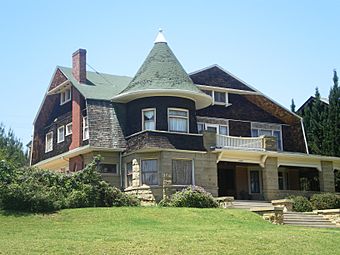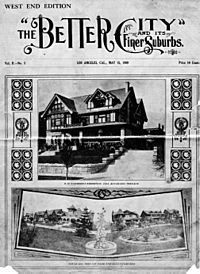Alvarado Terrace Historic District facts for kids
Quick facts for kids |
|
|
Alvarado Terrace Historic District
|
|

Gilbert House, 1333 Alvarado Terrace
|
|
| Location | Los Angeles, California |
|---|---|
| Built | 1902 |
| Architectural style | Bungalow/Craftsman, Modern Movement |
| NRHP reference No. | 84000783 |
| Added to NRHP | May 17, 1984 |
The Alvarado Terrace Historic District is a special neighborhood in Los Angeles, California. It's known for its beautiful old homes and a park. This district is located southwest of Downtown Los Angeles, near Pico Boulevard and Alvarado Street.
Six homes and a church in this area were recognized as Los Angeles Historic-Cultural Monuments in 1971. This means they are important historical places. Later, in 1984, the whole district was added to the National Register of Historic Places. This is a list of places important to the history of the United States.
Contents
History of Alvarado Terrace
How the Area Began
The land where Alvarado Terrace is today was once part of the original Pueblo of Los Angeles. This was the first Spanish settlement in the area, started in 1781.
In the late 1800s, a woman named Doria Deighton Jones owned this land. She was the widow of a successful grocer. Around 1897, the Los Angeles Golf Club rented the land. They built a nine-hole golf course there. People called it "Windmill Links" because an old windmill was used as the clubhouse.
Building the Neighborhood
In 1902, Mrs. Jones divided the land into smaller pieces for homes. These pieces of land were sold for $10 each. But there was a rule: buyers had to build a house that cost at least $4,000. This was a lot of money back then!
The area was promoted as a fancy place to live. People said it would be like "second Chester Place," which was a very rich street. By 1906, all the land was sold, and the neighborhood was full of new homes.
Terrace Park and Powers Place
Creating a Community Park
To make the neighborhood even nicer, one of its main supporters, Pomeroy Powers, helped create a park. Powers was also the president of the City Council. In 1904, the city built a park along Alvarado Terrace.
It was first called Summerland Park, but soon became Terrace Park. The park had a fish pond and pretty rosebeds. It even had a full-time gardener to take care of it. Later, the park was changed to have only grass and trees.
Los Angeles' Shortest Street
At the north end of Terrace Park, there's a small brick-paved street. It's called "Powers Place." This street is famous for being the "shortest street in Los Angeles."
Both the park and this tiny brick street were named a Historic-Cultural Monument in 1979. This shows how important they are to the city's history.
Six Special Homes
Alvarado Terrace is unique because six houses on one block are Historic-Cultural Monuments. These houses are all on the north side of the street. They were given this special status in July 1971.
These homes were built between 1902 and 1905. They show many different architectural styles. You can see Craftsman, Victorian, Mission, Tudor, and Shingle styles.
A brochure from 1903 described the neighborhood as very special. It said it was "the only exclusive Residential Tract in the city." It promised "Beautiful Parks" and "High Class building restrictions." This meant no apartments, small cottages, or stores were allowed.
Because of its park and well-kept homes, Alvarado Terrace looks like a complete historic neighborhood. It has even been used in movies and TV shows. Even though the area around it has changed, Alvarado Terrace still feels like a step back in time.
Boyle-Barmore House
The Boyle-Barmore House is at 1317 Alvarado Terrace. It was built in 1905. Architect Charles E. Shattuck designed it in a Craftsman style with some Tudor touches. It has three gabled dormers, which are windows that stick out from the roof.
Calvin A. Boyle, who helped start the Hollywood Board of Trade, built this house. Later, Edmund H. Barmore, president of the Los Angeles Transfer Company, bought it. For a time in the 1980s, the house was used as a place for women needing help.
Cohn House
Next is the Cohn House at 1325 Alvarado Terrace, built in 1902. Frank D. Hudson and William Munsell designed it. They also designed the Museum of Science and Industry in Exposition Park.
The Cohn House mixes Craftsman style with a first floor made of rough sandstone. The second floor has a Shingle style look. It also has three gabled dormers, making it look a bit like a Swiss chalet. Morris Cohn, a textile maker, owned this house. His home and his factory are both Historic-Cultural Monuments. In the 1980s, this house was used as a place for men needing help.
Gilbert House
The Gilbert House, at 1333 Alvarado Terrace, was built in 1903. Ida and Pomeroy Powers, who lived next door, built it to sell. This house is very striking with its mix of Victorian, Shingle-Style, and Craftsman designs.
Wilbur F. Gilbert, a rich oil man from Texas, was the first to buy and live in this house. His daughter, Carolyn McCulloch, lived there until she passed away in 1992.
Powers House
The Powers House at 1345 Alvarado Terrace was built in 1903 for Pomeroy Wells Powers and his wife Ida. Arthur L. Haley designed this home in the Mission Revival style. People have called it "exuberant" and the "flashiest on the block" because of its fancy stucco designs.
The house has a covered porch with arches that supports a second-floor balcony. Towers rise from the balcony, connected by a curved wall. A large corner tower has a special room that can only be reached from outside the house.
Pomeroy Powers was a lawyer and one of the original builders of Alvarado Terrace. He was also on the City Council. In the 1970s, Ann Gutierrez restored the house, fixing walls, plumbing, and wiring. In the 1990s, it became a restaurant called Salisbury Manor. People could eat downstairs and see the restored bedrooms upstairs.
Raphael House
The Raphael House at 1353 Alvarado Terrace is in the Tudor style and was built in 1903. Architects Sumner P. Hunt and Wesley A. Eager designed it. Hunt also designed other famous buildings in California.
Robert H. Raphael, who owned a glass company, first owned this house. It's known for its many beautiful stained and leaded glass windows. In 1995, some of its special features, like stained glass and fireplaces, were removed. The city stepped in and ordered them to be returned to protect its historical status.
Kinney-Everhardy House
The Kinney-Everhardy House at 1401 Alvarado Terrace was built in 1902. The same architects, Hunt & Eager, designed it as the Raphael House next door. This house combines elements from both the Queen Anne and Shingle styles.
First Church of Christ, Scientist
The district also includes the former First Church of Christ, Scientist. It was built in 1912 on a unique corner lot. Architect Elmer Grey designed the church. He also designed the Beverly Hills Hotel and the Pasadena Playhouse.
The church building has been described with different styles, including Beaux-Arts and Italian Romanesque. It has a round porch with columns, a brick tower, rounded arches, and a tiled roof.
This church was named a Historic-Cultural Monument in 1971. In 2008, the building was being used by a different church, the "Iglesia Adventista Central."
National Register of Historic Places
In 1983, the Alvarado Terrace area was suggested to become an official historic district. To help people learn about it, many homes were opened for tours. In 1984, the district received this important recognition. It was added to the National Register of Historic Places.
The Pico Union area, where Alvarado Terrace is, also became a Historic Preservation Overlay Zone (HPOZ) in 2004. This means there are special rules to help protect the historic look and feel of the neighborhood.
Images for kids









